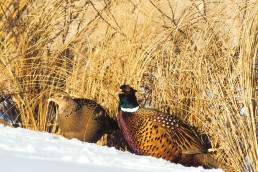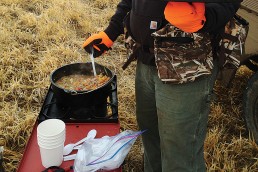More CRP Acres, Higher Pheasant Populations
SHARE THIS POST
Pheasant populations tied to habitat
South Dakota’s 2017 pheasant season will go down in history as a season of sparse pheasant populations and fewer hunters. That’s especially true compared to the heydays of a few years ago. Then, pheasant populations were high and hunters, especially those from out-of-state, showed up to shoot them.
The reasons for the decline in pheasant populations this season are pretty well known. Drought throughout the state seriously impacted pheasant broods. While, for pheasants and humans alike, drought, hailstorms and tough winters are all part of living in South Dakota, it is the decline in habitat that has made it difficult for overall pheasant populations to survive adverse conditions, including early droughts.
Send in the reserves
When it comes to pheasant populations, it’s not rocket science. If South Dakota had the acres of pheasant habitat it once had, pheasant numbers would have been much greater even with the drought. The breeding season would have started with a far greater population of birds. Those birds then would have produced more chicks. Surviving chicks would add to the numbers and lead to even greater populations. It’s simple math. A larger number of acres enrolled in the Conservation Reserve Program (CRP) would have also provided more forage benefits critical to support livestock during the drought.
This year’s pheasant season will be known for its lower bird counts. As one South Dakota newspaper’s headline declared, it was the season that “fizzled” . I sincerely hope this season will be remembered for a different reason. That it will provide the impetus for South Dakotans and elected officials to take action and prevent this situation from happening again. The fact is, a workable, broadly supported solution to improve pheasant habitat in South Dakota exists. That is the Conservation Reserve Program.
Are you enjoying this post?
You can be among the first to get the latest info on where to go, what to use and how to use it!
CRP on CPR
Pheasant populations hit their peak in South Dakota a decade ago. CRP enrolled 1.5 million acres in the state, then. Since then, due to budget cuts and caps on the number of acres allowed in the program, CRP acres have dwindled. Pheasant numbers have, as well. It’s not as though our landowner conservationists don’t have the desire to participate in the program. In fact, it’s the opposite. Last year, South Dakota landowners applied to enroll more than 42,000 acres during the regular signup for CRP. CRP accepted only two landowners and 101 acres. That’s right, only two landowners.
The US Congress is in the process of beginning to seriously consider the next Farm Bill. That measure determines how farm programs, such as CRP, will function and be funded. During their return trips to South Dakota, our state’s Congressional delegation—Senators Thune and Rounds and Congresswoman Noem—have been outspoken supporters of CRP and advocates for more dollars and acres for the program.
Solutions in sight
Disappointing 2017 pheasant numbers can be fixed. Whether you are a hunter, a business owner who benefits from hunting dollars spent in our state, or a landowner interested in conservation and alternative sources of revenue, you should reach out to the state’s congressional delegation. Ask them to voice their support for CRP. Take that support into the halls, offices and hearing rooms of our nation’s capital. Ask them to use their power to convince their colleagues to vote in favor of increased dollars and allowable acres for the program. Including allowing 1.5 million acres in CRP for South Dakota. Tell them we need a CRP that offers routinely scheduled general CRP signups. That 1.5 million figure reflects our long-term historic average enrollment. Plus, we need an ongoing CRP that targets specific tracts for wildlife.
Voluntary access provisions built on top of CRP, like our state’s walk-in program, can benefit both residents and non-residents. Doing that will not only benefit bird populations, but also businesses and main streets. Workers, landowners and South Dakota’s long, proud heritage of pheasant hunting can benefit from keeping the program strong.
MWO
SHARE THIS POST
Did you enjoy this post?
You can be among the first to get the latest info on where to go, what to use and how to use it!
MWO
We believe being outdoors is good. With more than 1,000 articles each year, MidWest Outdoors magazine is all about sharing outdoor experiences with you—where to go, what to use and how to use it… whether you’re close to home or on that trip of a lifetime.


